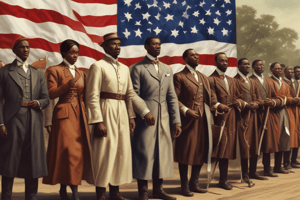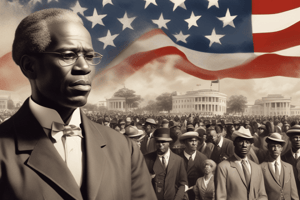Podcast
Questions and Answers
The Fourteenth Amendment was primarily focused on the economic recovery of the South.
The Fourteenth Amendment was primarily focused on the economic recovery of the South.
False (B)
Reconstruction faced significant opposition from pre-war southern leadership, influencing Congress to take a firmer stance.
Reconstruction faced significant opposition from pre-war southern leadership, influencing Congress to take a firmer stance.
True (A)
The Ku Klux Klan emerged as a group promoting the rights and freedoms of African Americans during Reconstruction.
The Ku Klux Klan emerged as a group promoting the rights and freedoms of African Americans during Reconstruction.
False (B)
The Fifteenth Amendment guarantees that voting rights cannot be denied based on race, color, or previous condition of servitude.
The Fifteenth Amendment guarantees that voting rights cannot be denied based on race, color, or previous condition of servitude.
Reconstruction was universally successful across different regions in the United States.
Reconstruction was universally successful across different regions in the United States.
The primary goal of Reconstruction was to maintain the political power of the northern states.
The primary goal of Reconstruction was to maintain the political power of the northern states.
President Johnson's Reconstruction Plan was fully supported by the Republican-led Congress.
President Johnson's Reconstruction Plan was fully supported by the Republican-led Congress.
The South successfully rebuilt its economy during the Reconstruction period without any external assistance.
The South successfully rebuilt its economy during the Reconstruction period without any external assistance.
The Ku Klux Klan was formed to support the rights of newly freed African Americans.
The Ku Klux Klan was formed to support the rights of newly freed African Americans.
The Fifteenth Amendment was meant to prevent any state from denying the right to vote based on race.
The Fifteenth Amendment was meant to prevent any state from denying the right to vote based on race.
Reconstruction was marked by a total absence of violence and conflict in the South.
Reconstruction was marked by a total absence of violence and conflict in the South.
The Fourteenth Amendment addressed issues of citizenship and equal protection under the law.
The Fourteenth Amendment addressed issues of citizenship and equal protection under the law.
The return of pre-war southern leadership was a significant factor that led to the Republican Congress taking control over Reconstruction efforts.
The return of pre-war southern leadership was a significant factor that led to the Republican Congress taking control over Reconstruction efforts.
The Fifteenth Amendment aimed to ensure that voting rights could not be denied based on economic status.
The Fifteenth Amendment aimed to ensure that voting rights could not be denied based on economic status.
During Reconstruction, the Ku Klux Klan was known for advocating for political reform in the South.
During Reconstruction, the Ku Klux Klan was known for advocating for political reform in the South.
Reconstruction was mainly successful in ensuring equal rights for African Americans throughout the Southern states.
Reconstruction was mainly successful in ensuring equal rights for African Americans throughout the Southern states.
President Johnson's Reconstruction Plan was met with significant support from southern leaders who were eager to rejoin the Union.
President Johnson's Reconstruction Plan was met with significant support from southern leaders who were eager to rejoin the Union.
The Fourteenth Amendment was instrumental in defining citizenship and ensuring equal protection under the law for all individuals.
The Fourteenth Amendment was instrumental in defining citizenship and ensuring equal protection under the law for all individuals.
The southern economy successfully rebuilt itself during Reconstruction without the need for federal intervention.
The southern economy successfully rebuilt itself during Reconstruction without the need for federal intervention.
The return of pre-war southern leadership had no impact on Congressional decisions regarding Reconstruction.
The return of pre-war southern leadership had no impact on Congressional decisions regarding Reconstruction.
Reconstruction in the North was entirely separate and had no connection to the issues faced in the South during the same period.
Reconstruction in the North was entirely separate and had no connection to the issues faced in the South during the same period.
What was a significant consequence of the return of pre-war southern leadership during Reconstruction?
What was a significant consequence of the return of pre-war southern leadership during Reconstruction?
What role did the Ku Klux Klan play during the Reconstruction era?
What role did the Ku Klux Klan play during the Reconstruction era?
How did the Fourteenth Amendment contribute to the goals of Reconstruction?
How did the Fourteenth Amendment contribute to the goals of Reconstruction?
What was a primary focus of Congress when taking control of Reconstruction?
What was a primary focus of Congress when taking control of Reconstruction?
Which of the following statements best reflects the outcomes of Reconstruction?
Which of the following statements best reflects the outcomes of Reconstruction?
Flashcards are hidden until you start studying
Study Notes
Reconstruction Overview
- Reconstruction aimed to rebuild the Union after the Civil War and address the status of freed African Americans.
- Key issues included political integration, economic recovery, and social reforms in the Southern states.
Freedom for African Americans
- Significant strides made towards African American emancipation and civil rights, including the abolition of slavery through the 13th Amendment.
- Establishment of schools, churches, and other institutions to support African American communities.
President Johnson's Reconstruction Plan
- Johnson’s plan allowed southern states to resume governance with minimal federal intervention.
- Key features included the swift restoration of Southern state governments but excluded meaningful protections for African Americans.
Opposition to President Johnson
- Resistance from Radical Republicans who sought greater rights for African Americans and a more stringent approach to Southern reintegration.
- Opposition to Johnson’s leniency led to escalating tensions between the President and Congress.
Fourteenth Amendment
- Ratified in 1868, granting citizenship and equal protection under the law to all persons born or naturalized in the U.S.
- It aimed to secure rights for African Americans and limit the power of ex-Confederate states.
Congress Takes Control of Reconstruction
- In response to Johnson's opposition, Congress enacted a more aggressive Reconstruction plan.
- The Military Reconstruction Act divided the South into military districts to oversee a transition to civil governance.
Fifteenth Amendment
- Ratified in 1870, prohibiting the denial of the vote based on race, color, or previous condition of servitude.
- Aimed to protect African American voting rights, though many states implemented discriminatory practices.
Reconstruction Governments
- New state governments established, often including African Americans in political positions.
- These governments faced significant opposition and violence from opponents committed to the old order.
Ku Klux Klan
- Founded in 1866 as a secret society aiming to suppress African American rights and maintain white supremacy.
- Engaged in violent actions, intimidation tactics, and voter suppression against both African Americans and allies.
Reconstruction Ends
- Marked by the Compromise of 1877, resulting in the withdrawal of federal troops from the South.
- Led to the rise of Jim Crow laws and systemic disenfranchisement of African Americans.
Rebuilding Southern Industry
- Focus on economic recovery included diversification beyond agriculture, emphasizing industries like textiles and railroads.
- Economic struggles persisted due to the devastation of war and extreme poverty in the region.
Reconstruction in the North
- The North underwent social and economic changes, including immigration influx and industrial growth.
- Northern attitudes toward Reconstruction shifted over time, affecting support for Southern political reform efforts.
Reconstruction Overview
- Reconstruction aimed to rebuild the Union after the Civil War and address the status of freed African Americans.
- Key issues included political integration, economic recovery, and social reforms in the Southern states.
Freedom for African Americans
- Significant strides made towards African American emancipation and civil rights, including the abolition of slavery through the 13th Amendment.
- Establishment of schools, churches, and other institutions to support African American communities.
President Johnson's Reconstruction Plan
- Johnson’s plan allowed southern states to resume governance with minimal federal intervention.
- Key features included the swift restoration of Southern state governments but excluded meaningful protections for African Americans.
Opposition to President Johnson
- Resistance from Radical Republicans who sought greater rights for African Americans and a more stringent approach to Southern reintegration.
- Opposition to Johnson’s leniency led to escalating tensions between the President and Congress.
Fourteenth Amendment
- Ratified in 1868, granting citizenship and equal protection under the law to all persons born or naturalized in the U.S.
- It aimed to secure rights for African Americans and limit the power of ex-Confederate states.
Congress Takes Control of Reconstruction
- In response to Johnson's opposition, Congress enacted a more aggressive Reconstruction plan.
- The Military Reconstruction Act divided the South into military districts to oversee a transition to civil governance.
Fifteenth Amendment
- Ratified in 1870, prohibiting the denial of the vote based on race, color, or previous condition of servitude.
- Aimed to protect African American voting rights, though many states implemented discriminatory practices.
Reconstruction Governments
- New state governments established, often including African Americans in political positions.
- These governments faced significant opposition and violence from opponents committed to the old order.
Ku Klux Klan
- Founded in 1866 as a secret society aiming to suppress African American rights and maintain white supremacy.
- Engaged in violent actions, intimidation tactics, and voter suppression against both African Americans and allies.
Reconstruction Ends
- Marked by the Compromise of 1877, resulting in the withdrawal of federal troops from the South.
- Led to the rise of Jim Crow laws and systemic disenfranchisement of African Americans.
Rebuilding Southern Industry
- Focus on economic recovery included diversification beyond agriculture, emphasizing industries like textiles and railroads.
- Economic struggles persisted due to the devastation of war and extreme poverty in the region.
Reconstruction in the North
- The North underwent social and economic changes, including immigration influx and industrial growth.
- Northern attitudes toward Reconstruction shifted over time, affecting support for Southern political reform efforts.
Reconstruction Overview
- Reconstruction aimed to rebuild the Union after the Civil War and address the status of freed African Americans.
- Key issues included political integration, economic recovery, and social reforms in the Southern states.
Freedom for African Americans
- Significant strides made towards African American emancipation and civil rights, including the abolition of slavery through the 13th Amendment.
- Establishment of schools, churches, and other institutions to support African American communities.
President Johnson's Reconstruction Plan
- Johnson’s plan allowed southern states to resume governance with minimal federal intervention.
- Key features included the swift restoration of Southern state governments but excluded meaningful protections for African Americans.
Opposition to President Johnson
- Resistance from Radical Republicans who sought greater rights for African Americans and a more stringent approach to Southern reintegration.
- Opposition to Johnson’s leniency led to escalating tensions between the President and Congress.
Fourteenth Amendment
- Ratified in 1868, granting citizenship and equal protection under the law to all persons born or naturalized in the U.S.
- It aimed to secure rights for African Americans and limit the power of ex-Confederate states.
Congress Takes Control of Reconstruction
- In response to Johnson's opposition, Congress enacted a more aggressive Reconstruction plan.
- The Military Reconstruction Act divided the South into military districts to oversee a transition to civil governance.
Fifteenth Amendment
- Ratified in 1870, prohibiting the denial of the vote based on race, color, or previous condition of servitude.
- Aimed to protect African American voting rights, though many states implemented discriminatory practices.
Reconstruction Governments
- New state governments established, often including African Americans in political positions.
- These governments faced significant opposition and violence from opponents committed to the old order.
Ku Klux Klan
- Founded in 1866 as a secret society aiming to suppress African American rights and maintain white supremacy.
- Engaged in violent actions, intimidation tactics, and voter suppression against both African Americans and allies.
Reconstruction Ends
- Marked by the Compromise of 1877, resulting in the withdrawal of federal troops from the South.
- Led to the rise of Jim Crow laws and systemic disenfranchisement of African Americans.
Rebuilding Southern Industry
- Focus on economic recovery included diversification beyond agriculture, emphasizing industries like textiles and railroads.
- Economic struggles persisted due to the devastation of war and extreme poverty in the region.
Reconstruction in the North
- The North underwent social and economic changes, including immigration influx and industrial growth.
- Northern attitudes toward Reconstruction shifted over time, affecting support for Southern political reform efforts.
Reconstruction Overview
- Reconstruction aimed to rebuild the Union after the Civil War and address the status of freed African Americans.
- Key issues included political integration, economic recovery, and social reforms in the Southern states.
Freedom for African Americans
- Significant strides made towards African American emancipation and civil rights, including the abolition of slavery through the 13th Amendment.
- Establishment of schools, churches, and other institutions to support African American communities.
President Johnson's Reconstruction Plan
- Johnson’s plan allowed southern states to resume governance with minimal federal intervention.
- Key features included the swift restoration of Southern state governments but excluded meaningful protections for African Americans.
Opposition to President Johnson
- Resistance from Radical Republicans who sought greater rights for African Americans and a more stringent approach to Southern reintegration.
- Opposition to Johnson’s leniency led to escalating tensions between the President and Congress.
Fourteenth Amendment
- Ratified in 1868, granting citizenship and equal protection under the law to all persons born or naturalized in the U.S.
- It aimed to secure rights for African Americans and limit the power of ex-Confederate states.
Congress Takes Control of Reconstruction
- In response to Johnson's opposition, Congress enacted a more aggressive Reconstruction plan.
- The Military Reconstruction Act divided the South into military districts to oversee a transition to civil governance.
Fifteenth Amendment
- Ratified in 1870, prohibiting the denial of the vote based on race, color, or previous condition of servitude.
- Aimed to protect African American voting rights, though many states implemented discriminatory practices.
Reconstruction Governments
- New state governments established, often including African Americans in political positions.
- These governments faced significant opposition and violence from opponents committed to the old order.
Ku Klux Klan
- Founded in 1866 as a secret society aiming to suppress African American rights and maintain white supremacy.
- Engaged in violent actions, intimidation tactics, and voter suppression against both African Americans and allies.
Reconstruction Ends
- Marked by the Compromise of 1877, resulting in the withdrawal of federal troops from the South.
- Led to the rise of Jim Crow laws and systemic disenfranchisement of African Americans.
Rebuilding Southern Industry
- Focus on economic recovery included diversification beyond agriculture, emphasizing industries like textiles and railroads.
- Economic struggles persisted due to the devastation of war and extreme poverty in the region.
Reconstruction in the North
- The North underwent social and economic changes, including immigration influx and industrial growth.
- Northern attitudes toward Reconstruction shifted over time, affecting support for Southern political reform efforts.
Studying That Suits You
Use AI to generate personalized quizzes and flashcards to suit your learning preferences.




